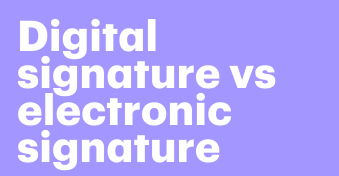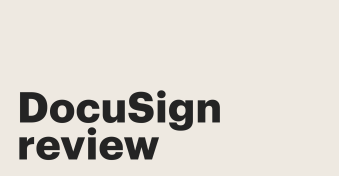While the demand for e-signing software has skyrocketed in recent years, it’s easy to forget that some e-signing providers have been around in the marketplace for decades.
That’s especially true in the real estate industry, where DocuSign and Authentisign are two viable solutions.
Both companies started 20+ years ago with the aim to help companies and their agents create authentic and legally binding electronic signatures.
But which one is a better fit for realtors, brokers, and agents?
In this article, we’ll compare and contrast these two e-signing solutions for realtors so that you know exactly what’s in store before you sign up.
Let’s get started.
Key takeaways
- Authentisign is aimed at the real estate industry and is designed specifically with realtors and brokers in mind.
- DocuSign is industry agnostic, meaning that it works with practically any business, but the company also offers plans exclusively for realtors.
- Both companies offer signatures that are considered legally binding by international law.
Quick note: This article talks about DocuSign from the perspective of real estate. If you’re not in the real estate industry, DocuSign — or one of its many other competitors — is likely to be a better fit for your needs.
Authentisign
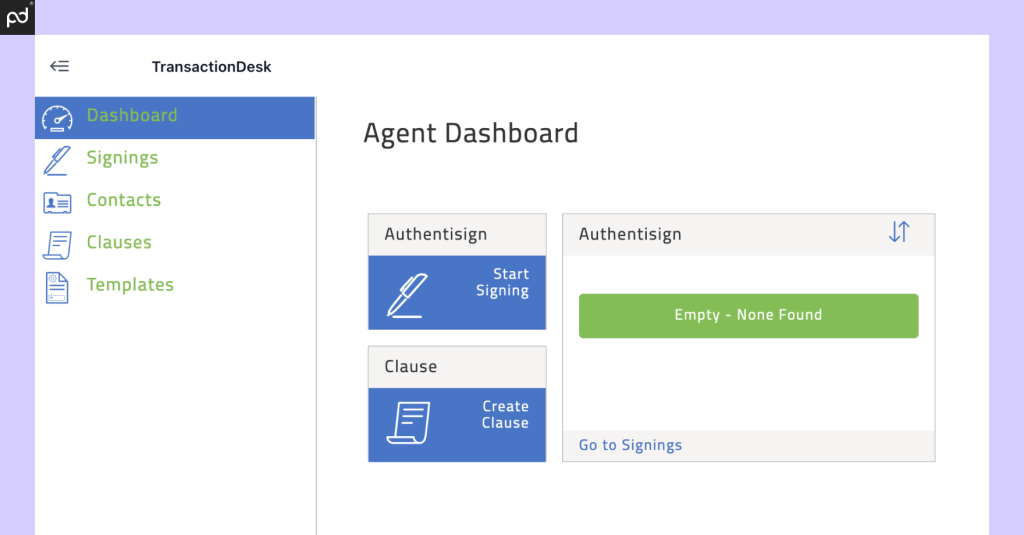
Pricing: $129/year.
Ease of use: 8.3/10
Free trial: Yes; 30 days.
Support: Knowledge base; support tickets; phone.
Authentisign is billed primarily as an e-signing solution for realtors.
This application is part of the TransactionDesk platform, operated by Lone Wolf Technologies, which provides cloud-based applications for real estate professionals aiming to digitize their digital processes.
Designed specifically for real estate workflows, Authentisign streamlines the e-signing process, enabling agents to send, sign, and manage documents efficiently.
While the tool can be used as a standalone product (and is compared to DocuSign in this way throughout the article), its integration with TransactionDesk means that it can be used in conjunction with other apps designed around document and transaction management.
Overall, Authentisign comes equipped with compliance and security features that ensure all signed documents meet industry standards.
However, the app’s singular focus on real estate and its integration with TransactionDesk limit its feature set and make it less appealing for agents who use other transaction management platforms.
As a standalone electronic signature software, Authentisign provides reasonable authentication for digital signatures, and its security standards are a great fit for real estate documents.
DocuSign
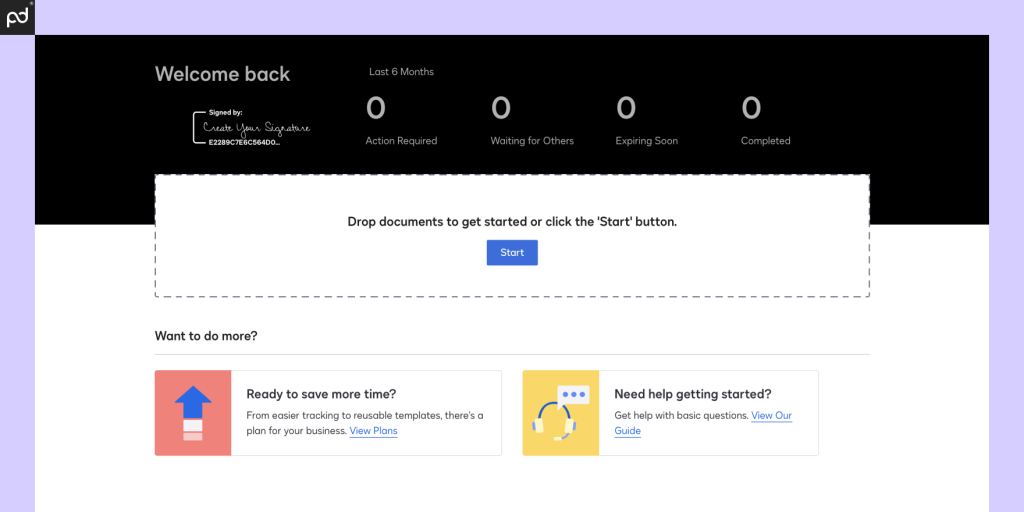
Pricing: Real Estate Starter ($15); Real Estate ($45); REALTORS ($35). All pricing based on monthly commitment. Enterprise solution available.
Ease of use: 9.0/10
Free trial: Yes; 30 days.
Support: Knowledge base; support tickets; additional support plans sold as separate packages.
DocuSign is a recognized leader in e-signatures and offers solutions to simplify the digital signing process for real estate professionals.
Its user-friendly platform and emphasis on security make it a trusted choice for handling sensitive documents.
As an e-signing service, DocuSign makes it easy for agents to accelerate transactions, obtain signatures remotely, and reduce paperwork.
Its integrations with popular real estate tools also help to streamline workflow and enhance overall efficiency.
Plus, DocuSign’s compliance features ensure that documents meet all legal requirements, so everyone can ensure that remotely acquired signatures are legally binding.
The company has carved out a unique niche for real estate transactions by providing a variation on its standard signing solution in partnership with the National Realtors Association.
This partnership provides most of the standard DocuSign features, in addition to a zipForm Plus integration, REALTOR®-logo branding, and forms specifically designed to streamline real estate transactions.
However, it’s worth noting that DocuSign comes with a few caveats. Although a robust option, DocuSign serves real estate as a secondary market.
The platform offers standardized and scalable solutions for businesses in other industries at a variety of price points.
Features on those plans — including ways to capture payments, bulk send documents, delegate signing authority between team members, and more — may not be available on real estate plans.
Authentisign vs DocuSign at a glance
Want to see how DocuSign and AuthentiSign compare to one another?
While we’ll cover the key differences in the following sections, here’s a closer look at what each platform has to offer:
| Plan Details | DocuSign | Authentisign |
|---|---|---|
| Core product | ||
| E-signature capture | ✓ | ✓ |
| Real-time audit trail | ✓ | ✓ |
| Notifications | ✓ | ✓ |
| Language support | ✓ | Limited |
| Mobile app | ✓ | ✓ |
| E-signing features | ||
| Signing order | ✓ | ✓ |
| Send to multiple recipients | ✓ | ✓ |
| In-person signing | ✓ | ✓ |
| Collaboration tools | ✓ | Limited |
| Strikethrough | ✓ | ✓ |
| Document prep | ||
| Drag & drop fields (PDF) | ✓ | ✓ |
| Create templates | ✓ | ✓ |
| From-scratch document builder | X | X |
| Pre-built template library | Limited | X |
| Custom branding | ✓ | X |
| Signer attachments | ✓ | X |
| Integrations & API | ||
| Import & storage | ✓ | ✓ |
| CRM | ✓ | Limited |
| Productivity | Limited | X |
| API | $ | X |
| Support | ||
| Email / ticketing support | ✓ | ✓ |
| Chat support | X | X |
| Knowledge base | ✓ | ✓ |
| Phone | X | X |
In the interest of fairness, this table compares DocuSign’s NAR-member exclusive Realtors plan ($240/year) to Authentisign’s default plan ($129/year).
DocuSign also offers a similar plan for non-NAR members, as well as enterprise and starter plans for agents with varying levels of commitment and experience.
Authentisign only offers one plan, at one rate, to all subscribers.
Requirements, workflows and pricing
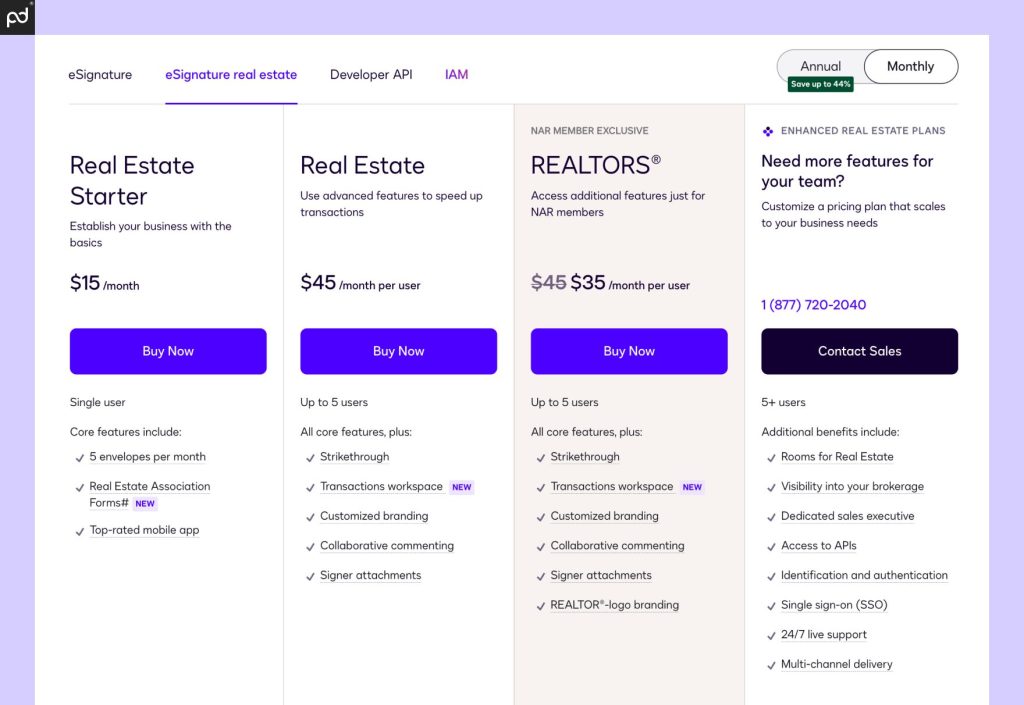
At a fundamental level, Authentisign and DocuSign share similarities in their basic layout and use case. Both platforms are browser-based, and both feature tools aimed at real estate agents.
Both platforms are primarily designed to fit into the end of the document workflow.
This means that the actual documents users need will need to be created somewhere else — such as within a word processing platform — and then uploaded to DocuSign or AuthentiSign for e-signing.
However, there are a few key differences based on how the platforms are set up.
DocuSign is an industry-agnostic tool and is designed to work for companies of any size, regardless of their chosen niche.
For real estate, the platform offers three separate plans for realtors (outside of enterprise-level brokerage plans), meaning that independent agents could easily purchase their own plan out of pocket.
In many ways, that seems to be the intended solution.
All of the off-the-shelf real estate plans can host a maximum of five users, which make them ideal for solo agents or for a small agency with a limited number of members.
Beyond five users, DocuSign offers Enhanced Real Estate plans, which are custom-built solutions designed by the in-house sales team.
These plans tend to offer a broader range of features, but they’re likely to cost more than the standard plans.
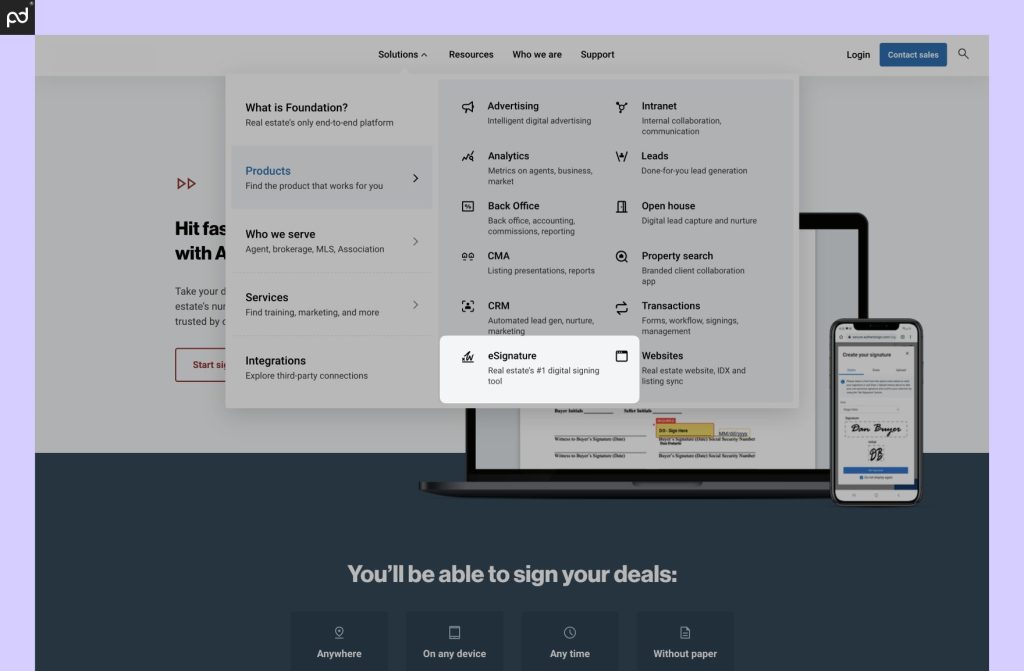
By comparison, Authentisign costs roughly $100 less than what you’re likely to pay with DocuSign, but saving that money comes with a few tradeoffs.
This happens because of how Authentisign is supposed to integrate with other TransactionDesk products.
Strictly speaking, it’s possible to purchase Authentisign as a standalone product.
However, this tool is designed to handle document signing in conjunction with other applications on the TransactionDesk platform.
The intent is that documents will be prepared and managed in another TransactionDesk application and then handed off to Authentisign to create a complete realtor workflow.
This solution is ideal for users who intend to integrate with Lone Wolf’s entire technology solution, but it places Authentisign at a clear disadvantage against a solution like DocuSign, which is primarily designed as a standalone product.
Because of this, several features available in DocuSign — signer attachment, custom branding, reporting options, and more — simply aren’t available in Authentisign because the app wants to hand those responsibilities off to other TransactionDesk solutions.
Our suggestion
If you’re planning to invest in the entire TransactionDesk suite from Lone Wolf Technologies, Authentisign is the go-to solution to automate e-signature capture.
However, for brokers and realtors planning to use another platform for a substantive portion of the sales and management workflow, Authentisign won’t make sense, despite its lower price point.
In those cases, it makes the most sense to use DocuSign.
Notably, both platforms are largely focused on document preparation, which is wholly different from tools like PandaDoc, which offers from-scratch document creation through our in-house document editor.
If you’re looking for the ability to edit your real estate contracts during negotiation without having to upload multiple revisions, neither DocuSign or Authentisign will have much to offer.
- Authentisign makes sense if you want to save some money or if you’re planning to use other Lone Wolf Technologies tools.
- DocuSign is better if you want an improved signing experience and a more robust document preparation toolkit.
- PandaDoc is a clear winner if you need from-scratch document creation and on-the-fly editing functionality during contract negotiations.
Document preparation and formatting
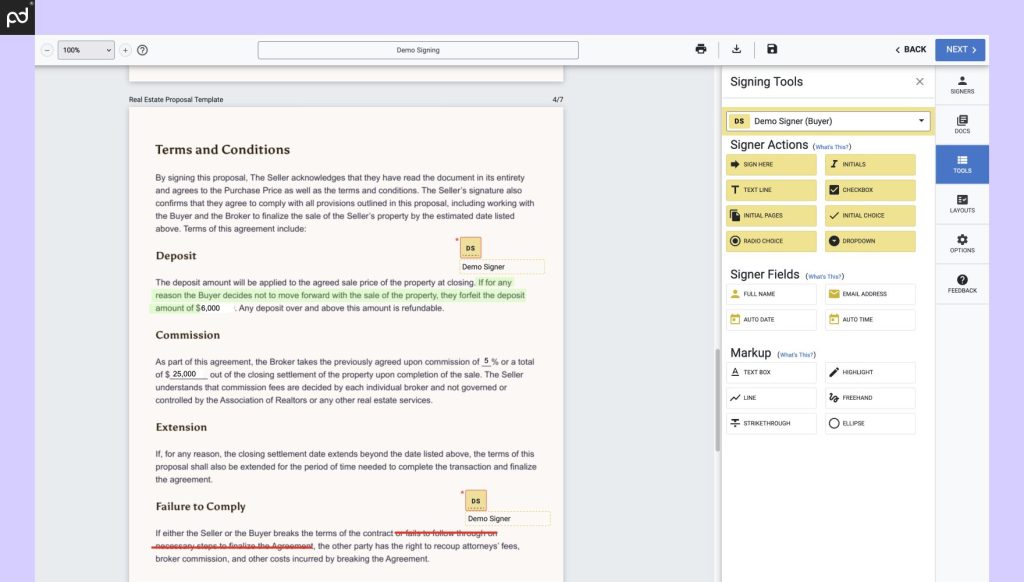
We took a close look at the document preparation process for both DocuSign and Authentisign when creating this article.
From our testing, we found that both platforms offer a similar signing experience.
Authentisign felt faster to use, but there were more hiccups along the way.
Many of the visual cues that are standard in drag-and-drop document preparation software weren’t included, which increased navigation issues and difficulty during use.
For example, with DocuSign or PandaDoc, users will click on the field / block they intend to add to the document and drag it into the editing area.
With Authentisign, users need to click the field they want to add, then click again on the document where the field should be added.
There are no visual cues to indicate that a field has been selected.
With some time and practice, some of these pain points would be eliminated as users gain an increased understanding of the software, but the experience in other tools made Authentisign feel very rudimentary by comparison.
Users will also experience a small learning curve. Some of the tools are hidden within panels or dropdowns and weren’t immediately obvious at first glance.
That, combined with the lack of visual and selection cues, further elongated the formatting process.
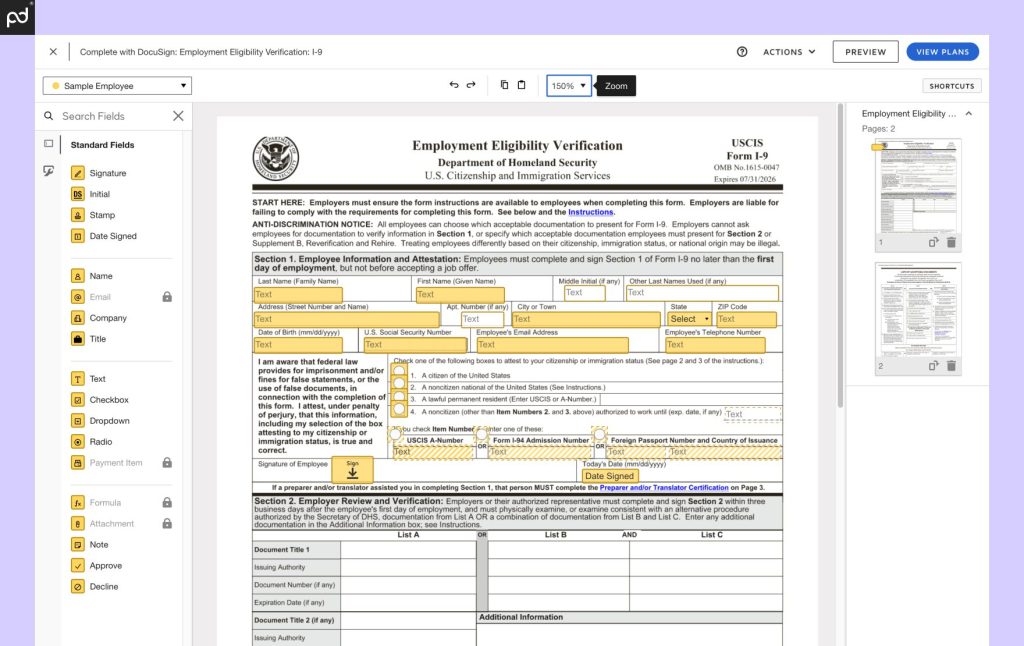
By comparison, the DocuSign workflow feels more structured and logical, but there are more steps to the process and it takes a little longer to set everything up.
There are a few more screens to navigate and a bit more handholding to make sure that users don’t miss steps or get lost in the process.
The workflow is very structured, and all DocuSign screens are built with the express purpose of helping signers start and move through the digital signing process.
This is also true on mobile devices (iOS and Android), where DocuSign users can easily manage documents and forms.
The abundance of visual cues and the clear drive to push signers into the intended workflow helps to reduce confusion and ensure that processes are executed quickly. Advanced users who are comfortable with the process will also be able to skip many of these steps by setting up reusable templates.
Our suggestion
If you’re looking solely at the end result, the document creation process won’t have much of a bearing on your final decision.
That being said, the DocuSign workflow feels like a more measured and thought-out experience. Veteran users may feel like the extra screens are unnecessary, but we found them useful to ensure that we didn’t miss any important steps along the way.
Plus, handling issues like adding signers and setting a signing order prior to formatting the document allowed the setup wizard to better anticipate what we needed in order to fully prepare the document.
In fact, PandaDoc also utilizes a similar document setup process. When you create a new document, a popup will ask who should sign the document, giving you an option to input all the essential details early. You can add this information after you’ve set up the document, if you prefer, but the workflow is there to help.
Unfortunately, Authentisign doesn’t really offer much to ease the document preparation process. You’ll add the signers as part of the setup process, along with the fields. If your document doesn’t meet the minimum requirements (at least one signer), the system will notify you. Otherwise, you’re largely on your own.
Final verdict:
- DocuSign or PandaDoc if you’re looking for a more structured workflow.
- Authentisign if you’d prefer fewer guardrails.
Building for realtors
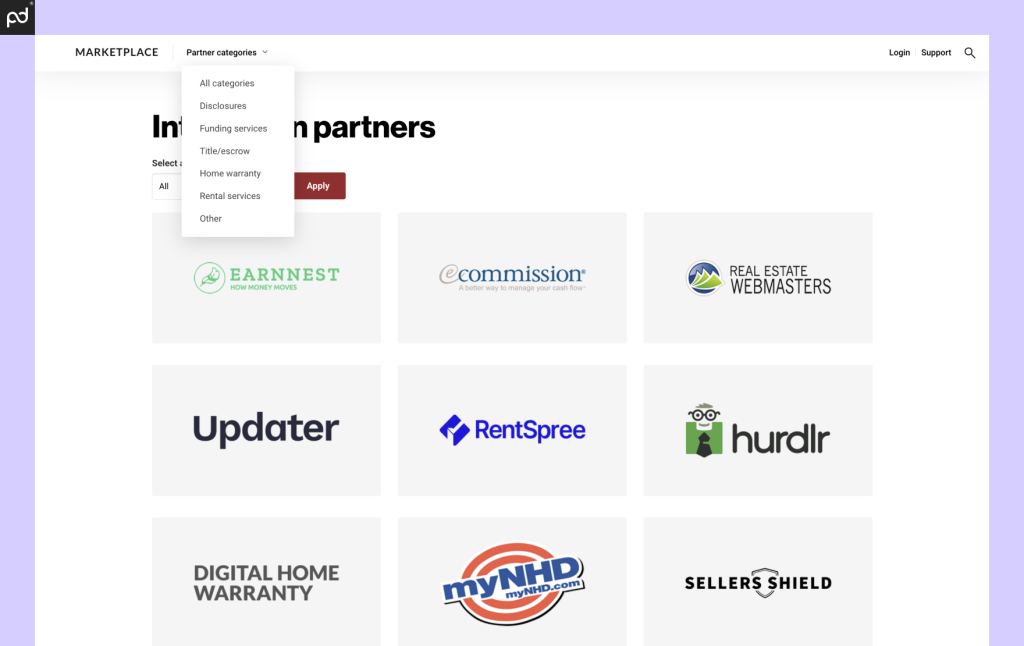
Despite the fact that both Authentisign and Docusign are targeted toward realtors, we found that most of the features and workflows in the software don’t feel unique to the industry.
Both platforms offer adequate document preparation, but there is only a limited amount of overlap between this process and information specific to real estate documentation. In fact, there are other solutions out there that do it better.
Authentisign is built by a brand focused entirely on real estate, and the entire product suite reflects that focus. Despite that fact, Authentisign could reasonably be used as a standalone e-signing product.
The platform failed to offer any industry-specific solution at the operational level that sets it apart from other e-signing solutions.
This is different from a competitor like dotloop, which has taken steps to ensure that every aspect of its product experience matches its intended use case.
With more applications from the Lone Wolf Technologies suite attached, it’s possible that Authentisign transforms into a very niche-focused real estate product, but there was no way for us to adequately test and verify that claim.
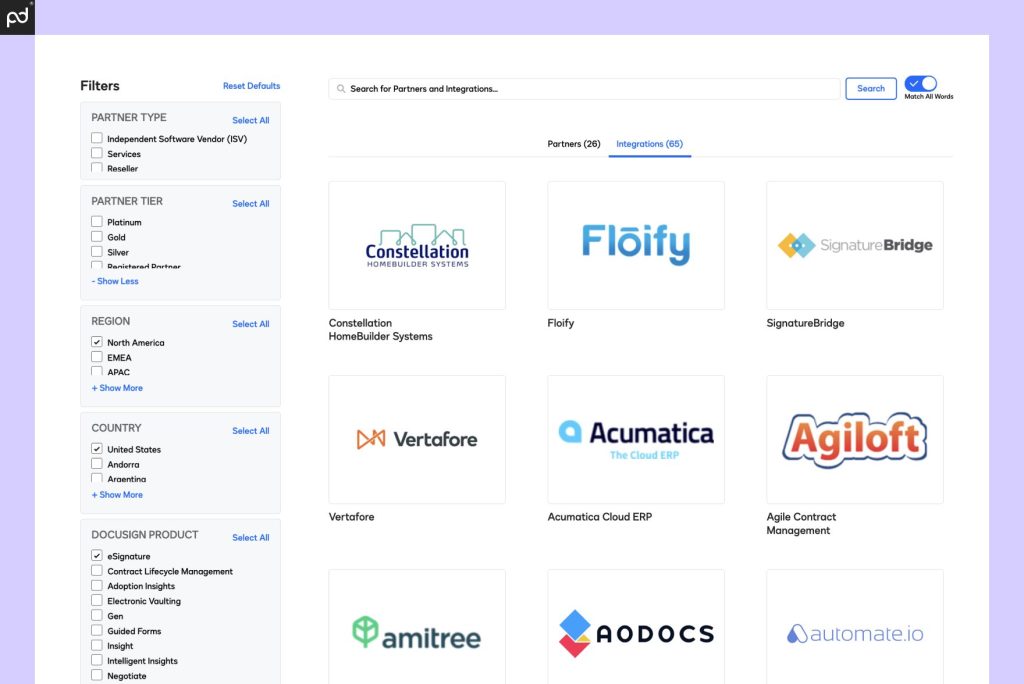
DocuSign finds itself in a similar position to Authentisign when discussed as a standalone product, but for different reasons.
The DocuSign platform was built without an industry focus and is largely being targeted to realtors through marketing and dealmaking with the NAR.
Inherently, the platform only offers a few key features that aren’t found on standard DocuSign plans (including strikethrough and zipForm integration).
The existing workflow on the real estate plans is practically identical to that of the standard plans, and the same limitations exist when it comes to integrations with CRMs like Salesforce or access to API tools.
All of these additions are available — for a cost.
Our suggestion
In our testing, we found that (similar to PandaDoc) both DocuSign and Authentisign were largely industry agnostic when used as standalone products.
Despite its branding and Lone Wolf Technologies’ clear market position, it would be entirely possible to use Authentisign on its own as a signing solution for practically any industry.
DocuSign is similar. The platform offers e-signing plans that are wholly separate from real estate. If not for the integrations, few branding options, and real estate forms, the real estate plans would be indistinguishable from the regular product options.
If you’re looking for signing solutions that are heavily integrated with industry specifics, Authentisign is likely the better bet — but not as a standalone software tool.
Final verdict:
- As a standalone software option, both tools only offer limited features exclusive to realtors.
- Authentisign likely has better overall integration with unique real estate features if you buy into the rest of the company platform.
- Alternative solutions like dotloop may offer more realtor-focused workflows for users who crave added specificity.
Alternatives to AuthentiSign and DocuSign
As standalone options, neither Authentisign or DocuSign bring much to the table that sets them apart from other signing solutions.
Both are adequate on their own, but there isn’t anything unique that makes them must-have solutions for realtors.
With that in mind, it’s worth remembering that there are other e-signing solutions on the market that can do a great job.
Here’s a quick list:
Each of the software options listed here will bring something unique to the table.
PandaDoc offers from-scratch document creation while dotloop has been a big hit with realtors over the years for its approach to real estate transaction management.
Build better docs with PandaDoc!
The world of e-signing solutions is vast and varied.
Both Authentisign and Docusign bill themselves as solutions specifically for the real estate industry.
Both companies also use this marketing approach to differentiate themselves from other competitors in the field.
However, from our testing and research, we haven’t found any reason that other e-signing options can’t serve a similar purpose — especially when operating as standalone solutions.
While we’d recommend that you test both software options for your business needs, don’t be afraid to consider a wide range of platforms that can comprehensively perform all the functions you might require.
The shortfall with many e-signing solutions is that they offer functionality that is limited in scope.
That’s especially true when compared to platforms like PandaDoc, which offers e-signing as part of a complete and holistic document solution.
But you don’t have to take our word for that.
Sign up for a free 14-day trial or a personalized demo to see how thousands of businesses work smarter by consolidating their document process into a single, streamlined workflow.
We know you’ll love it!
Disclaimer
PandaDoc is not a law firm, or a substitute for an attorney or law firm. This page is not intended to and does not provide legal advice. Should you have legal questions on the validity of e-signatures or digital signatures and the enforceability thereof, please consult with an attorney or law firm. Use of PandaDocs services are governed by our Terms of Use and Privacy Policy.
Originally published March 21, 2022, updated August 30, 2024

